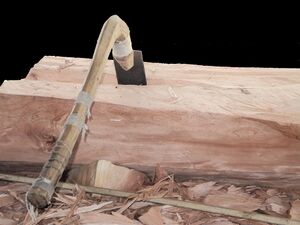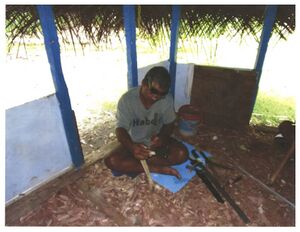Micronesian adzes
Carolinian Canoes, or proas, are the most singular, striking, and technologically complex artifact of Micronesia. Today, they remain both a useful and sustainable form of transportation, as well as a defining symbol of the people and the region, particularly in the Outer Islands of Yap and Chuuk.
Essential to the fabrication of proas is the adze, a handled cutting tool for shaping, squaring, and most importantly, hollowing, wood. The Micronesian adze needed for hollowing canoe hulls is a unique and refined type. Initially carvers mounted stone, and later shell, blades. Contact with the West introduced sharper, longer lasting metal blades, which were individually fabricated by smiths to replace shells blades with little change to the design and traditional use of the adzes.
defining tool of Micronesia
“Salesius, a member of a German scientific team which visited the Micronesian area around the turn of the century, offered his personal observations on the relationship of the Yapese men to their adzes:
‘It [the adze] is so indispensable because it is almost the only tool of the Yapese, replacing for him every possible kind of cutting implement, the saw, the chisel, the knife, the plane and must, therefore, be at hand every moment . . . In short, for him the axe [sic, adze] is a universal instrument which he knows how to manipulate with extraordinary skill as a result of his varied and constant use of it (1907:48).’
While this account may not accurately reflect the tool inventory which the Yapese utilized, it does reflect the central position this single class of implements held, generally, in Oceania.” [1]
use in fabrication of Carolinian Canoes
“Carved wooden objects have reached their apex in the deep sailing canoes of the Carolines. The navigational and canoe building skills of these people are noted throughout the Pacific and are a great source of pride even today... Canoes are chiefly constructed from breadfruit wood and without the use of nails. Before the introduction of metal from the west, trees were felled and hollowed using rudimentary stone age tools. Shell-bladed adzes accomplished the cutting and planing of wood while wedge and fire techniques assisted in the felling and initial hollowing of the tree.” [2]
“The features of modern proas are seen to have been wholly present in the early days, including the oceanic metrical hull with its characteristic lateen sail, outrigger, black and red designs, asymmetrical metrical hull with its characteristic black and red designs, forked headpieces, and, on large canoes, the rudder and two storage huts. If anything in the Carolines has remained steadfast over the centuries, it is the artfully contrived and universally admired flying proa. It is as if near-perfection had been so achieved that it would be sacrilegious if not foolish to tamper with the design.”[3]
Habele Adze Blades
Western styles of adzes, with metal heads or collars, are typically mounted to a straight wooden handle much as a hammer, pickaxe or axe is. In contrast, Micronesian adze blades are lashed to the handle with dried, rolled coconut fiber cord, making the distinctive ways of forming and using it, more integral to the tool’s purpose. Modern attempts to improvise the blades using scrap metal, such as old truck suspension springs, “compromise quality, safety and traditional techniques,” said Neil Mellen, founder of Habele.[4]
In 2012, master toolsmith Jim Wester of North Bay Forge on Waldron Island, WA, who has been making customized blades for traditional and modern carvers around the world since 1987, was commissioned by Habele to produce several large blades. The blades were donated to Waa’gey, a Yap-based nonprofit organization that “uses traditional skills to confront the social, economic, and environmental challenges faced by the people of Micronesia’s most remote outer islands.” Waa’gey’s cofounder and master canoe builder, Larry Raigetal, said, “The blades are by far the best quality the guys here have ever seen.”bWorking with Waa’gey and Habele donors, Wester continued to deliver special orders for high quality steel adzes when the Yapese carvers provided the exact size, shape, curvature and weight needed to align with their hand carved handles.
In 2019, Habele formally launched the “Micronesian Adze Blade” project “to design adze blades that precisely meet the needs of Carolinian canoe carvers, and the specifics of their traditional tool design and usage practices.” It was a larger scale, more data-driven version of their work up to that point. A Technical Assistance Program grant from the U.S. Department of the Interior provided the necessary funding to support the design and development of steel versions of the traditional Micronesian blades.
A detailed survey of the carvers’ preferences was conducted, while research provided the opportunity to assess historical specimens as well as contemporary blades used throughout the region. Hours were spent pouring through archives, reviewing published field notes, and interviewing craftsmen. A partnership was then formed with metalsmith Paul Garrett of the John C. Campbell Folk School in Brasstown, NC, and “a design was created by Micronesian carvers that balanced historic design elements of shell blades, characteristics of the most effective metal blades now in use, and refinements in metallurgy that facilitate more efficient longer-lasting bevels,” Mellen said.
Two prototypes were forged by Garrett initially and sent to carvers for field tests. A second batch with refinements followed. The final working design was fine-tuned based on that feedback and were completed in 2022, at which point blade distribution began.
- ↑ Craib, John Ligertwood. ”A Typological Investigation Of Western Micronesian Adzes.” Unpublished Masters Thesis. California State University, Long Beach, M.A., 1977.
- ↑ Martin, Lynn. "An Approach To Central Carolinian Aesthetics." Unpublished Masters Thesis. University of Hawaii, Honolulu, M.A. 1981
- ↑ Lessa, William. "An Evaluation of Early Descriptions of Carolinian Culture." Ethnohistory, Vol. 9, No. 4 (Autumn, 1962), pp. 313-403.
- ↑ https://habele.org/2022/03/09/unique-adze-blades-for-traditional-micronesian-canoe-carvers/




